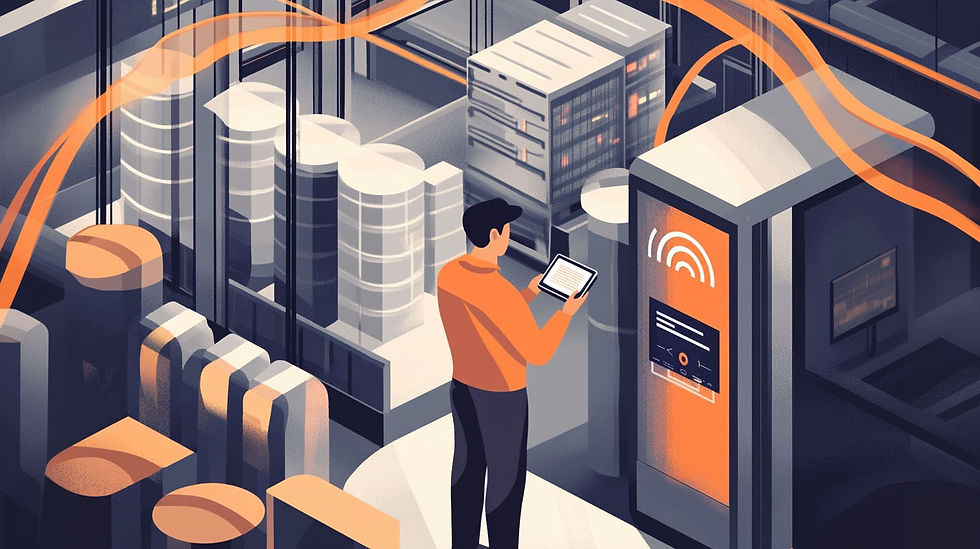The Impact of a Connected Workforce on Your Bottom Line
- PinPoint
- Jun 4, 2024
- 4 min read

In today's fast-paced business environment, the concept of a connected workforce is rapidly gaining traction. A connected workforce leverages digital tools and technologies to ensure seamless communication, collaboration, and productivity among employees. This approach is not just a trend but a strategic necessity that significantly impacts an organization’s bottom line. In this article, we'll explore how a connected workforce can enhance your business operations and profitability.
Enhancing Communication and Collaboration
Effective communication and collaboration are the bedrocks of a productive workforce. Traditional methods, such as emails and phone calls, are often slow and inefficient. In contrast, digital platforms enable instant communication and collaboration across different locations and time zones.
Improved Communication Channels
With tools like instant messaging, video conferencing, and collaborative platforms, employees can share information and ideas in real-time. This reduces the time spent waiting for responses and accelerates decision-making processes. Moreover, features like group chats and collaborative documents ensure that all team members are on the same page, minimizing misunderstandings and errors.
Enhanced Team Collaboration
A connected workforce fosters a culture of collaboration. Employees can work together on projects regardless of their physical location, breaking down silos and encouraging the free flow of information. This leads to more innovative solutions and improves problem-solving capabilities. Collaborative platforms also enable real-time feedback and brainstorming sessions, which can significantly enhance project outcomes.
Boosting Productivity and Efficiency
A connected workforce is synonymous with higher productivity and efficiency. Digital tools streamline workflows, automate routine tasks, and provide employees with the resources they need to perform their jobs more effectively.
Streamlined Workflows
Digital platforms enable the automation of repetitive tasks, freeing up employees to focus on more strategic activities. For example, workflow automation tools can handle tasks such as data entry, appointment scheduling, and report generation. This not only saves time but also reduces the likelihood of human error.
Access to Information
In a connected workforce, employees have instant access to information and resources. Cloud-based platforms ensure that all necessary documents, data, and tools are available at their fingertips, whether they are in the office or working remotely. This accessibility enhances their ability to perform tasks efficiently and effectively.
Performance Monitoring and Feedback
Digital tools allow for continuous performance monitoring and feedback. Managers can track employee progress in real-time, identify areas for improvement, and provide constructive feedback promptly. This helps employees stay on track and make necessary adjustments to their work practices, leading to better performance and productivity.
Reducing Costs and Increasing Profitability
A connected workforce can lead to significant cost savings and increased profitability. By leveraging digital tools and technologies, organizations can optimize their operations, reduce overhead costs, and achieve better financial outcomes.
Reduced Operational Costs
Digital transformation reduces the need for physical infrastructure and resources. For example, cloud-based storage eliminates the need for physical file storage, and virtual meetings reduce travel expenses. Additionally, remote work capabilities can lead to lower office space and utility costs.
Increased Employee Retention
A connected workforce promotes employee satisfaction and retention. Digital tools that facilitate flexible work arrangements, continuous learning, and professional development contribute to a positive work environment. Satisfied employees are more likely to stay with the company, reducing turnover rates and the associated costs of recruiting and training new staff.
Enhanced Customer Satisfaction
A connected workforce is better equipped to meet customer needs promptly and effectively. Real-time communication tools enable faster response times and more personalized customer interactions. By providing superior customer service, organizations can enhance customer satisfaction, loyalty, and ultimately, profitability.
Driving Innovation and Agility
In today’s competitive landscape, innovation and agility are crucial for business success. A connected workforce fosters a culture of continuous improvement and adaptability, driving innovation and agility.
Fostering Innovation
Digital collaboration tools allow employees to share ideas and collaborate on projects more effectively. This collaborative environment encourages creative thinking and innovation. Employees can easily exchange insights, brainstorm solutions, and develop new ideas that drive business growth.
Enhancing Agility
A connected workforce can quickly adapt to changing market conditions and customer demands. Digital tools enable rapid communication and decision-making, allowing organizations to pivot their strategies and operations as needed. This agility is crucial for staying competitive and capitalizing on new opportunities.
Case Study: Connected Workforce
Consider a manufacturing company that implemented a connected workforce strategy using the PinPoint app. Before the implementation, the company faced challenges such as communication delays, inefficiencies in task management, and high operational costs.
Implementation and Results
The company introduced PinPoint to enhance communication, streamline workflows, and reduce costs. The app provided real-time corrective and preventive actions (CAPA), task management, and performance tracking features. Employees could access all necessary information and resources from their mobile devices, whether on the factory floor or working remotely.
As a result, the company saw a significant improvement in communication and collaboration. Workflow automation reduced the time spent on repetitive tasks, allowing employees to focus on more strategic activities. Operational costs decreased due to the reduced need for physical infrastructure and travel. Most importantly, employee satisfaction and retention rates improved, contributing to a more stable and productive workforce.
Conclusion
The impact of a connected workforce on your bottom line is profound. By enhancing communication, boosting productivity, reducing costs, and driving innovation, a connected workforce enables organizations to achieve better financial outcomes and stay competitive in the market. Implementing digital tools and technologies, such as the PinPoint app, can transform your workforce and pave the way for long-term success.
For organizations looking to leverage the benefits of a connected workforce, embracing digital transformation is not just an option but a necessity. By investing in the right tools and fostering a culture of connectivity and collaboration, businesses can unlock new levels of efficiency, productivity, and profitability.
Ready to transform your workforce and boost your bottom line? Reach out to PinPoint at info@pinpointworkforce.com to discover how our mobile-first solutions can help you build a connected workforce and drive business success.



Comments